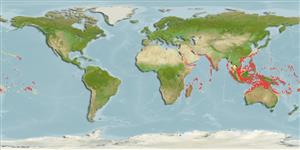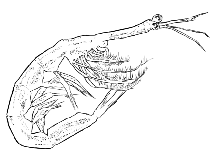Lucifer chacei Bowman, 1967
| Native range | All suitable habitat | Point map | Year 2050 |

|
| This map was computer-generated and has not yet been reviewed. |
| Lucifer chacei AquaMaps Data sources: GBIF OBIS |
Classification / Names Common names | Synonyms | CoL | ITIS | WoRMS
Malacostraca | Decapoda | Luciferidae
Environment: milieu / climate zone / depth range / distribution range Ecology
Pelagic; depth range 10 - 100 m (Ref. 96667). Tropical; 33°N - 33°S, 27°E - 135°W
Distribution Countries | FAO areas | Ecosystems | Occurrences | Introductions
Indo-Pacific: Eastern Africa to Hawaii and Tahiti. Tropical and subtropical.
Length at first maturity / Size / Weight / Age
Maturity: Lm ? range ? - ? cm
Short description Morphology
Last segment of peduncle of ant. 2 in male reaches beyond eye and nearly distal margin of 1st segment of ant. 1 peduncle, in female reaches beyond middle of cornea and to distal third of 1st segment of ant. 1 peduncle; rostrum reaches proximal border of statocyst; ventral cushion of male telson much broader than its posterior height; sheath of petasma curved.
Planktonic (Ref. 75706) and coastal (Ref. 78954) species. Feeds on both phyto- and zooplanktons (Ref. 97303).
Life cycle and mating behavior Maturity | Reproduction | Spawning | Eggs | Fecundity | Larvae
Growth from eggs to adults (7-8 mm) takes more or less 3 weeks (Ref. 97303). After fertilization, eggs remain attached to the females by short stalks to the ischia of the third pereopods until hatching (Ref. 78954).
Main reference
References | Coordinator | Collaborators
Pérez Farfante, I. and B. Kensley. 1997. (Ref. 75620)
IUCN Red List Status (Ref. 130435)
CITES status (Ref. 108899)
Not Evaluated
CMS (Ref. 116361)
Not Evaluated
Threat to humans
Human uses
| FishSource |
Tools
More information
Internet sources
BHL | BOLD Systems | CISTI | DiscoverLife | FAO(Publication : search) | Fishipedia | GenBank (genome, nucleotide) | GloBI | Gomexsi | Google Books | Google Scholar | Google | PubMed | Tree of Life | Wikipedia (Go, Search) | Zoological Record
Estimates based on models
Preferred temperature
(Ref. 115969): 25 - 29, mean 28 (based on 1502 cells).
Price category
(Ref. 80766):
Unknown.



